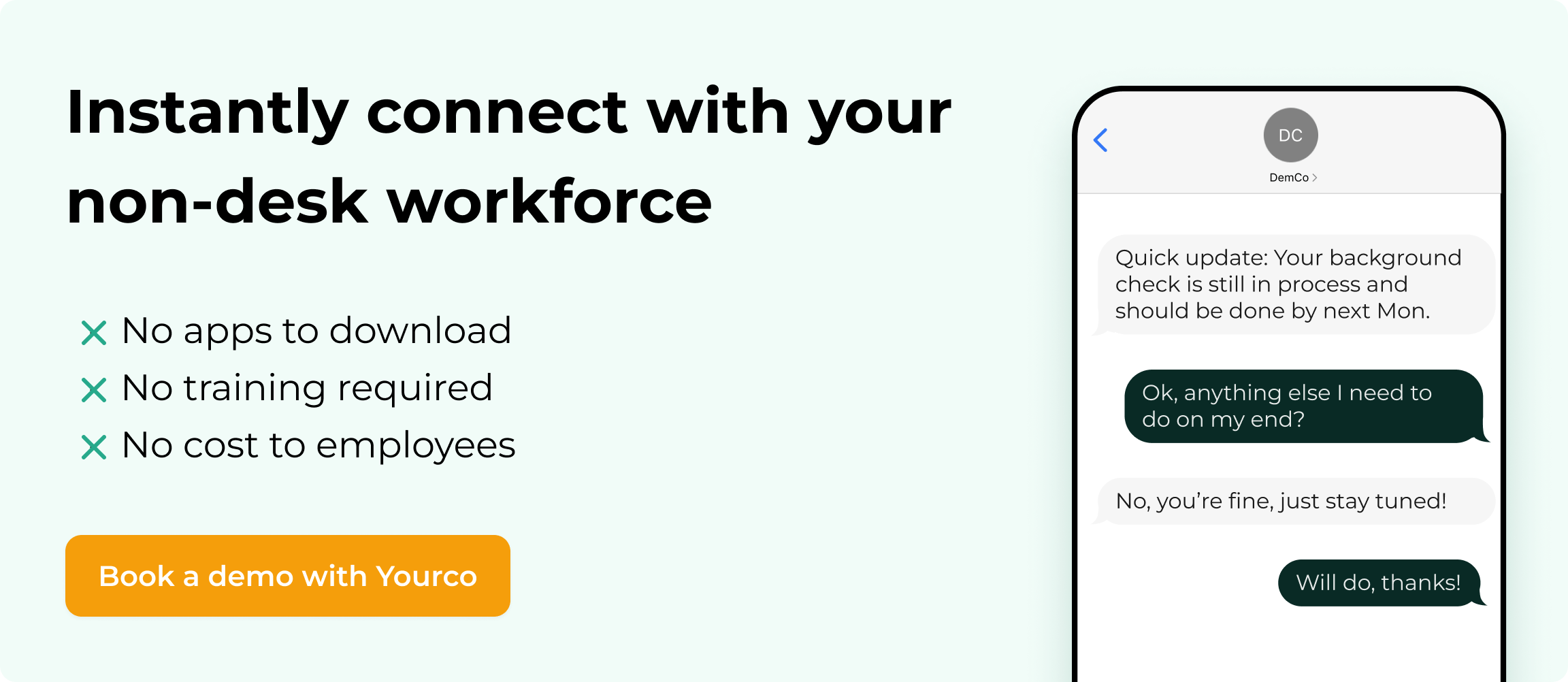Mastering Schedule Conflicts: The Ultimate Guide for HR Leaders


Ever had your schedule ping with a reminder for a site safety check just as a client calls needing urgent assistance with a delayed shipment? Or found yourself juggling staffing issues when multiple warehouse workers request the same day off during peak season? Rings a bell, doesn't it? Situations like these create unnecessary stress, especially when coordinating employees spread across various shifts, locations, and roles.
Schedule conflicts don't just cause stress—they undermine productivity and strain relationships among teams. However, managing these conflicts doesn't require magic, just the right tools and strategies.
Whether you're handling production schedules, field service appointments, or employee availability, understanding why schedule conflicts occur and how to effectively resolve them transforms chaos into smooth operations. Let's dive into overcoming these challenges and building reliable schedules that benefit everyone involved.
Differentiating Schedule Conflict Types
Understanding different types of scheduling issues helps identify the most effective solutions:
- Schedule Conflict: This refers to issues within an existing schedule or timetable where clashes appear in an already established schedule. Examples include when an employee can't work a requested shift due to personal commitments or a venue is unavailable on a specific date due to prior bookings. These conflicts typically happen in environments with fixed schedules or when resources have already been allocated.
- Scheduling Conflict: This focuses on problems in the process of creating a schedule. Examples include difficulties coordinating meetings between multiple stakeholders, challenges creating conflict-free course schedules in schools, or problems arranging shifts that work for both business needs and employee preferences.
Common Causes of Schedule Conflict
Schedule conflict arises from various sources in both workplace and personal settings. Recognizing these root causes is the first step toward effective prevention and resolution:
Double Bookings and Overlapping Commitments
Double booking happens when someone gets scheduled for two different tasks at the same time. This usually happens through human error, especially with outdated scheduling methods. Picture a manager accidentally putting an employee in two positions during the same shift. Similarly, overlapping shifts create confusion when one shift's end doesn't match another's beginning, leaving you either overstaffed or understaffed.
For small businesses, even simple shared calendars decrease booking conflicts substantially. Clear visual indicators of busy time blocks help team members avoid requesting meetings during periods already committed to other activities.
Without real-time synchronization or alerts, updates made in one place may not carry over to others, compounding confusion. Automated systems can flag potential overlaps and enforce rules to prevent double assignments.
Resource Allocation Issues
In project environments, conflicts pop up when multiple teams need the same limited resources at once. Without proper visibility across departments, different project managers might book the same specialized equipment or personnel simultaneously. Manufacturing companies experience this when specialized machine operators are scheduled by two different production managers unaware of each other's plans.
Software development teams face similar challenges when multiple projects require the same technical specialist. Implementing resource management tools that show availability across the organization helps prevent these conflicts. Successful companies establish clear request processes for shared resources with sufficient lead time requirements to accommodate competing needs.
Poor Communication and Visibility
Many schedule conflicts come from communication gaps. Without clear channels, people make decisions based on incomplete information. Think of a team lead booking an important client meeting without checking if key team members already have other commitments.
For instance, healthcare organizations suffer when practitioners don't communicate time-off requests early, creating coverage gaps. Meanwhile, retail managers struggle when employees don't promptly share availability changes.
Regular schedule check-ins and transparent sharing of calendar information reduces these communication-based conflicts significantly. Organizations that implement consistent communication standards about scheduling see measurable improvements in coordination and fewer last-minute scrambles.
Even in hospitality settings, unclear messaging between front desk staff and housekeeping can lead to overlapping shift coverage or missed responsibilities. Centralized tools help maintain visibility and accountability across teams.
Time Zone Differences
Time zones create major scheduling headaches for remote teams. A perfect meeting time for New York might force Singapore colleagues to join in the middle of their night.
Teams without clear time zone protocols often schedule calls at unsuitable hours, reducing participation and effectiveness. Simple practices like always specifying the time zone when scheduling and using world clock tools help minimize these issues.
Some distributed teams establish "golden hours" when all team members are expected to be available, limiting meeting scheduling outside these windows. Additionally, rotating meeting times can share the burden fairly among team members across different regions.
Last-Minute Changes and Emergencies
Unexpected events throw wrenches into carefully planned schedules. Urgent client requests, equipment failures, or personal emergencies force teams to quickly shuffle resources and priorities, creating conflicts with existing commitments. Service industries particularly struggle with this as customer demands fluctuate unpredictably. Construction projects face weather delays that cascade through schedules.
Healthcare providers deal with patient emergencies that disrupt planned appointments. Organizations that build flexibility into their scheduling practices recover more quickly from these disruptions. Successful companies establish clear protocols for handling emergencies while minimizing impact on existing commitments. Organizations can prepare for emergencies by establishing clear protocols and effective communication strategies.
Poor Planning and Lack of Buffer Time
Scheduling without breathing room between activities creates a domino effect when tasks run long. Without transition time, people find themselves constantly late, missing the start of meetings, or stressed as they rush from one thing to the next. Service businesses see this when appointments are scheduled back-to-back with no allowance for sessions that take longer than expected.
Event planners experience cascading delays when transitions between activities aren't adequately accounted for. Realistic time estimation combined with deliberate buffer periods significantly reduces schedule pressure. Companies that analyze historical data about task duration make more accurate time allocations, reducing the frequency of scheduling conflicts caused by unrealistic timelines.
Impacts of Schedule Conflict
Schedule conflict goes far beyond simple inconvenience, creating ripple effects throughout organizations and personal lives. These impacts show up in three key areas: productivity, stress levels, and team dynamics.
Productivity Impacts
When schedule conflict happens, productivity takes a measurable hit:
- Disrupted Workflow: Conflicts interrupt workflow, forcing employees to switch contexts repeatedly.
- Reduced Collaboration: When team members can't sync their schedules, collaborative work stalls. Projects needing multiple perspectives and skills get delayed, hurting quality.
- Increased Absenteeism: Ongoing scheduling issues can lead to higher absenteeism as employees get frustrated with the chaos. This creates staffing shortages that further hurt operations.
- Operational Inefficiencies: In industries like manufacturing or hospitality, scheduling conflicts can mean idle equipment, underused facilities, and service gaps—all directly hitting the bottom line.
Organizations that measure and track scheduling effectiveness find direct correlations between conflict reduction and productivity increases across almost all business functions.
Stress Level Impacts
The human cost of schedule conflict is just as significant:
- Elevated Anxiety and Burnout: The constant pressure to resolve conflicting priorities increases stress. Gallup research shows that unreasonable time pressure is one of the top five causes of employee burnout.
- Emotional Fallout: Employees facing ongoing scheduling conflicts report higher levels of frustration and resentment. These negative emotions often spill into personal lives, affecting overall well-being.
- Mental Health Concerns: Approximately 39% of employees attribute their primary workplace stress to workload issues, according to Pollack Peacebuilding—a figure that rises when scheduling problems compound existing workload concerns.
Organizations increasingly recognize these human impacts of poor scheduling. Employee assistance programs now often include time management components to address scheduling-related stress. Companies that implement flexible scheduling options report lower burnout rates among staff.
Team Dynamics Impacts
Perhaps most concerning are the long-term effects on team cohesion and culture:
- Erosion of Trust: When schedule conflict repeatedly disrupts team plans or forces last-minute changes, trust erodes. Team members begin to doubt each other's reliability and commitment.
- Diminished Team Morale: Teams dealing with chronic scheduling issues experience lower morale.
- Culture Erosion: Over time, unaddressed scheduling issues can damage workplace culture. When employees feel their time isn't respected, they respond with reduced engagement and commitment.
- Conflict Escalation: What starts as a simple scheduling conflict can grow into personal antagonism between team members or departments, creating divisions that affect multiple aspects of workplace functioning.
Organizations with effective scheduling practices report higher employee satisfaction scores, particularly regarding workplace culture and team dynamics. Management teams that address scheduling conflicts promptly and fairly maintain better team cohesion.
Providing real-time feedback can further enhance employee engagement and improve team dynamics. Data from employee engagement surveys consistently shows that respect for time and schedule needs ranks among the top factors influencing perceptions of organizational culture and values.
Strategies for Resolving Schedule Conflict
When schedule conflict arises, having a systematic approach to resolution can transform potential chaos into manageable solutions. Here are effective strategies to address conflicts once they occur:
Clear Communication
For frontline teams, conflicts should be addressed immediately through clear, direct, and transparent communication. Since frontline workers typically begin their days with brief onsite meetings, it’s crucial that scheduling communication is straightforward and timely.
When scheduling conflicts occur, such as overlapping shifts or coverage gaps, bring all relevant supervisors or shift leaders together promptly to openly discuss available options. Organizations that utilize structured communication protocols specifically designed for shift management, including standardized text-based notifications or briefings, report quicker conflict resolutions and higher satisfaction among frontline workers.
Timeline and Commitment Adjustments
Review all affected commitments and consider which can be rescheduled, shortened, or handled differently:
- Reprioritize tasks based on urgency, importance, and dependencies
- Split longer meetings into shorter segments that fit around fixed commitments
- Delegate portions of work when appropriate
This flexible approach recognizes that not all commitments carry equal weight or require the same format. Developing strategies to handle no shows can mitigate the impact of absenteeism on scheduling. Construction companies that regularly review and adjust project timelines based on resource availability complete more projects on schedule.
Meanwhile, healthcare practices that offer varied appointment lengths to accommodate different patient needs maximize provider schedules more effectively. Organizations that establish clear methods for evaluating the relative importance of competing time demands make better decisions when conflicts arise.
Collaborative Problem-Solving
Encourage team-based solutions, particularly for shift work environments:
- Create systems for voluntary shift swaps that give employees agency
- Develop a shared responsibility model for coverage
- Use group problem-solving sessions for complex scheduling challenges
Collaborative approaches to workplace challenges often increase solution quality and implementation success. Using methods to gather employee feedback can further enhance collaborative problem-solving efforts. Manufacturing facilities with employee-driven shift exchange programs report higher worker satisfaction and lower absenteeism.
Hospitality businesses that implement collaborative scheduling approaches experience lower turnover rates among hourly staff. Team-based scheduling solutions generally produce more sustainable results than top-down directives, especially for recurring schedule conflicts.
Tools and Technologies for Managing Schedule Conflicts
When choosing tools to manage schedule conflicts, it's essential to recognize that office workers and non-desk employees have distinctly different needs. Office workers typically benefit from calendar-based scheduling software, email integrations, and desktop platforms due to consistent access to computers and stable internet connections. However, these tools often fall short for non-desk workers, who frequently lack continuous internet access, face mobile data restrictions, or struggle with complex apps.
For non-desk employees—such as frontline workers, warehouse staff, or field service teams—SMS-based employee solutions are among the most effective tools available. SMS platforms specifically address the unique needs of this workforce. Here's a practical overview of technologies that help teams coordinate more effectively:
SMS-Based Employee Platforms
Text messaging remains one of the most accessible communication technologies, making SMS-based platforms particularly valuable for schedule management. These systems offer:
- Universal accessibility without requiring smartphones or internet access
- Real-time notifications that reach employees immediately
- Simple response mechanisms for confirming shifts or reporting issues
- Direct communication channels between managers and staff
SMS platforms like Yourco are especially effective for deskless workforces in retail, hospitality, healthcare, and manufacturing, cementing SMS as a primary tool in employee communication. Their accessibility ensures all employees stay informed regardless of technology access or digital literacy levels.
Furthermore, companies looking to set up SMS messaging find that such systems overcome language and technology barriers that hamper other communication methods. The immediacy of text messaging allows for rapid response to sudden schedule changes or urgent coverage needs.
For instance, managers can schedule text messages to efficiently disseminate updates at optimal times.
Shared Calendars and Scheduling Platforms
For office workers, digital calendars work perfectly, especially as digital calendars have evolved far beyond simple date tracking. Modern shared calendar systems offer:
- Conflict detection that automatically flags double-bookings
- Resource scheduling for rooms, equipment, and shared assets
- Availability indicators showing when team members can meet
- Integration with email and messaging platforms
Google Calendar, Microsoft Outlook, and Apple Calendar all provide these essential features, but specialized platforms like Calendly add capabilities for external scheduling without the back-and-forth emails.
Moreover, organizations find that visualization of time commitments through color-coding and calendar overlays helps team members identify potential conflicts before they become problems. Educational institutions report particular success using shared calendars to coordinate classroom usage and faculty availability across departments.
Integration Capabilities
The most effective scheduling technologies don't exist in isolation. Look for tools that integrate with:
- Human resource information systems (HRIS)
- Payroll platforms
- Project management software
- Communication tools
- Time and attendance tracking
Implementing communication integration ensures seamless workflows and improved scheduling accuracy. This integration creates a seamless workflow that reduces data entry errors and keeps information consistent across systems. Organizations with integrated technology ecosystems report fewer discrepancies between scheduling systems and payroll records.
Construction companies that connect project management tools with personnel scheduling platforms make more accurate resource allocation decisions. Meanwhile, manufacturing operations find that integrating production scheduling with employee shift management improves overall efficiency and reduces overtime costs. The data flowing between interconnected systems provides valuable insights for future scheduling decisions and organizational planning.
Using Yourco as a Scheduling Tool for Non-Desk Workers
For operations managers handling frontline or deskless employees, Yourco provides streamlined, efficient scheduling solutions designed specifically for teams without constant internet access or complex software. Here’s how Yourco helps operations managers coordinate schedules effectively:
1. Send Schedules via SMS
Operations managers can instantly deliver daily, weekly, or monthly schedules directly to employees’ mobile phones—no smartphone or internet connection required. This ensures all employees stay informed in real-time.
Example:
“Hi Ana, your shift this week is Mon-Fri, 7am–3pm. Reply ‘YES’ to confirm.”
2. Share Schedule Links
Yourco lets managers include clickable links in SMS messages, opening detailed schedules directly in a mobile browser. Employees can easily access comprehensive schedules in formats like Google Sheets or PDFs without printing or manual searching. Yourco also includes file view tracking and analytics, allowing managers to confirm who has reviewed schedules.
Example:
“View the full monthly schedule here: [link]”
3. Send Shift Reminders
Automated or manual shift reminders via Yourco significantly reduce no-shows and improve attendance. Employees receive timely prompts, allowing them to confirm or communicate any conflicts promptly.
Example:
“Reminder: You’re scheduled for tomorrow (Tue) at 6am. Please reply if you can’t make it.”
4. Notify Employees of Schedule Changes
When schedules change unexpectedly, Yourco enables managers to instantly notify employees via SMS, sharing new shift details or updated schedule links. Employees can promptly respond, clarify changes, or coordinate further as needed.
Example:
“Your shift on Wednesday has been moved to 10am–6pm. View the updated schedule: [link]”
Leveraging Yourco’s SMS-based scheduling ensures seamless communication, enhanced employee accountability, and efficient management of scheduling conflicts, especially tailored to non-desk teams.
Say Goodbye to Schedule Conflict Headaches
The best organizations don't just react to schedule conflict; they prevent it. Through regular schedule reviews, smart buffer time, clear priorities, and connected technology, they create environments where schedule conflict is a rare exception.
Remember that scheduling tools only work as well as the communication around them. Teams that talk openly about constraints, priorities, and changes handle schedule conflict better when it does arise. This is especially true for workers without desks, where accessible communication methods like text messaging prove invaluable for quick updates and solutions.
As the #1 SMS-based employee app in the market built specifically for the non-desk workforce, Yourco helps organizations eliminate schedule conflict before it happens.
With Yourco's platform, managers can instantly send schedule updates directly to employees' phones via text message, no smartphone app required. This means your team receives real-time notifications about shift changes, can quickly confirm availability, and report potential schedule conflict without technology barriers.
Try Yourco for free today or schedule a demo and see the difference the right workplace communication solution can make in your company.



